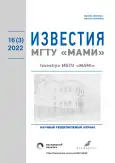Предпосылки для создания отечественных средств бортовой диагностики для автомобилей категории М1 и М2
- Авторы: Завойкин В.А.1
-
Учреждения:
- Государственный научный центр Российской Федерации «Центральный научно-исследовательский автомобильный и автомоторный институт» «НАМИ»
- Выпуск: Том 16, № 3 (2022)
- Страницы: 235-240
- Раздел: Транспортные и транспортно-технологические комплексы
- URL: https://bakhtiniada.ru/2074-0530/article/view/126630
- DOI: https://doi.org/10.17816/2074-0530-108512
- ID: 126630
Цитировать
Полный текст
Аннотация
Обоснование. В связи с неуклонным ростом мирового парка автомобилей при усложнении их рабочих функций, и увеличением числа электронных блоков управления и их технологичности на борту транспортного средства, возрастает потребность в средствах доступа к показателям работы бортовых электронных систем на конечных стадиях их производства и эксплуатации. Данный обзор необходим для обобщения имеющихся данных из мирового опыта по построению и реализации систем бортовой диагностики.
Цель работы – состоит в формулировании общих принципов построения систем бортовой диагностики, которые позволят наметить рациональные технические решения для поставленной задачи по созданию собственной отечественной диагностической среды для транспортных средств.
Материалы и методы. В настоящей работе описано назначение и роль систем бортовой диагностики, используемых в мировой практике для современных автотранспортных средств. Выделены классы диагностических устройств по уровню реализуемых функций. Рассматриваются основания, определяющие необходимость разработки собственных систем бортовой диагностики колесных транспортных средств. Проведён обзор функционала оригинальных диагностических средств производителей зарубежных автомобилей. Определены основные требования, предъявляемые разработчикам со стороны группы стандартов ISO 27145 и ISO 14229 в рамках реализации современных диагностических систем для отечественных автотранспортных средств категории М1 и М2.
Результаты. Определён конкретный набор функций, рекомендованных для интегрирования в диагностическое оборудование, создаваемое в рамках перспективных отечественных разработок. Сформулировано содержание положительного эффекта от практической реализации мероприятий, предложенных по результатам выполненного анализа.
Заключение. Выполненный научный анализ особенностей существующего диагностического оборудования позволяет определить актуальные направления при реализации принципиально нового направления в бортовые диагностики в РФ, что способствует повышению уровня компетенции отечественных специалистов и разработок в рамках стратегии развития отечественного машиностроения.
Полный текст
Открыть статью на сайте журналаОб авторах
Владислав Анатольевич Завойкин
Государственный научный центр Российской Федерации «Центральный научно-исследовательский автомобильный и автомоторный институт» «НАМИ»
Автор, ответственный за переписку.
Email: vlad.zavoykin@nami.ru
ORCID iD: 0000-0002-2624-9280
SPIN-код: 7703-0195
инженер, аспирант
Россия, 125438, Москва, ул. Автомоторная, д. 2Список литературы
- Santini A. OBD-II: Functions, Monitors and Diagnostic Techniques. Delmar: Delmar Cengage Learning, 2010.
- Petrovsky S.V., Kozlovsky V.N., Kritsky A.V., et al. On-Board Intelligent Information System for Diagnosing Faults in the Ignition System of a Passenger Car // 2021 Intelligent Technologies and Electronic Devices in Vehicle and Road Transport Complex, TIRVED 2021 – Conference Proceedings. Moscow: IEEE, 2021. doi: 10.1109/TIRVED53476.2021.9639141
- Козловский В.Н., Петровский С.В., Новикова А.П. Интеллектуальная информационная система диагностики состояния автономных транспортных объектов // Фундаментальные исследования. 2016. № 6–1. С. 73–77.
- Сергеев Д.В., Левкин И.В. Разработка распределенной информационно-советующей системы диагностики и управления автомобилем // Вестник алтайской науки. 2010. № 2. С. 20–26.
- ISO 27145-1:2012 Road vehicles – Implementation of World-Wide Harmonized On-Board Diagnostics (WWH-OBD) communication requirements – Part 1: General information and use case definition.
- OEM tools. https://oemtools.com [internet] (дата обращения: 04.04.2022).
- ISO 15765-3:2004 Road vehicles – Diagnostics on Controller Area Networks (CAN) – Part 3: Implementation of unified diagnostic services (UDS on CAN).
- ISO 14229-1:2020 Road vehicles – Unified diagnostic services (UDS) – Part 1: Application layer.
Дополнительные файлы







